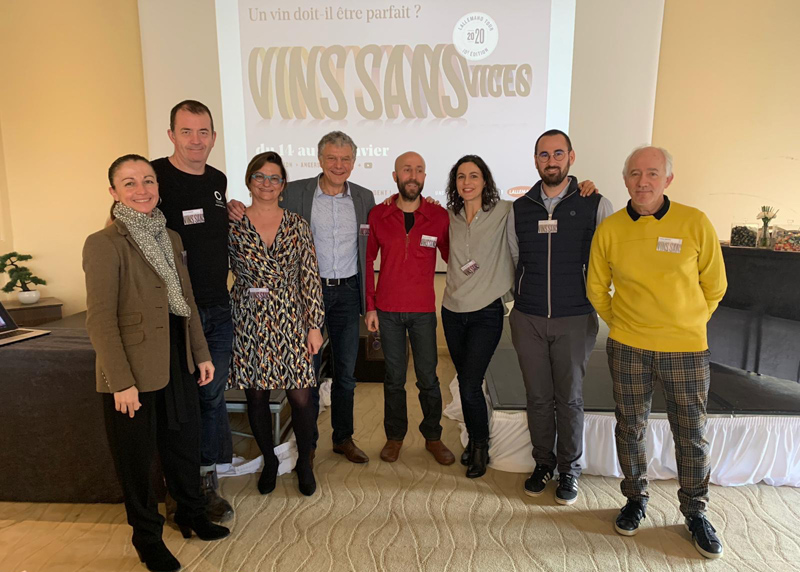
I’m just preparing a presentation I’m giving in the Netherlands tomorrow, and I came across two pictures I took in the vineyards at Waterkloof in Stellenbosch, South Africa. The first is of one of their vineyards that has been managed biodynamically from the start, which is above. [It’s not an old vineyard.] The soils had a loose structure and were quite pliable.
The second, below is from a vineyard that was previously managed with herbicides. It has just been converted to biodynamics. The two vineyards are only a few paces apart, and share the same soil type, but the vineyard managed with herbicides is like a road.

Clean cultivating using herbicides (most commonly glyphosate, which is relatively benign) has profound effects on the soil structure. It has effects on the soil microlife, too. It’s generally a really bad idea, but it saves lots of money, and the vineyards look very tidy and orderly.
Gradually, people are beginning to appreciate the importance of what goes on below the ground in viticulture. Plant roots exude a range of organic nutrients such as organic acids, sugars, amino acids, nucleosides and mucilage. This encourages the development of a community of microbes, including some – called plant growth-promoting rhizobacteria (PGPR) – that interact with the roots in specific ways, including altering the root structure itself. They promote nutrient uptake and can help plants tolerate drought stress, among other things.

A recent paper by Patricia Piccoli (above) and colleagues looked at what’s taking place under the ground in Catena’s Adrianna vineyard, in Mendoza, Argentina – and specifically which bacterial strains are present in the soil. They took root and soil samples every 10 cm to a depth of 80 cm. These were placed in sterile pots and then taken to the laboratory, where the work of characterizing the various bacteria present began. After culturing and examining the various isolated strains, Patricia analysed the DNA to identify the species present. In all, 11 strains of soil bacteria were isolated, and these were from 10 different genera. Of these, two were selected as having characteristics of plant growth promoting rhizobacteria (PGPR). These were Bacillus licheniformis and Pseudomonas fluorescens, both of which produced the plant hormones abscisic acid (ABA), indole-3-acetic acid (IAA) and the gibberellins A1 and A3. They also colonized roots of Malbec grape vines grown in controlled conditions in pots. Vines that had these bacteria on their roots showed ABA levels that were increased 76-fold by B. licheniformis and 40-fold by P. fluorescens, when compared with controls. These bacteria slowed down the rate of water loss in the vines, and this slowing of water loss correlated with increased ABA levels. Because the levels of ABA found were so high, Patricia and colleagues think this indicates that the increase is due to production by the bacteria plus production by the vine as a response to the interaction with the microorganisms.
The bacteria also increased the production of terpenes, which are associated with plant defence against microbial attack. Interestingly, high levels of terpenes were found in the aerial part of the vine whereas the bacteria were present just on the roots. This suggests that these bacteria are able to cause what is known as induced systemic resistance in vines, because the synthesis of terpenes was found mainly in leaves, which would be the part of the vine mainly subject to any microbial attack.
There’s a lot happening under the ground that’s really important in viticulture, and we don’t know enough about it. But killing soil life by using herbicides is clearly a silly thing to do.
17 Comments on The effect of herbicides on soil structure

Thank you for this article!
It was very educational and made me want to ‘dig deeper’ to learn more!
Merci Jamie!
Excellent work. This is important wine journalism as this really matters to everyone.
Can’t agree more! The use of compost, legumes; and other cover crops rather than synthetic fertilisers also makes a significant contribution to soil health.
Great post Jamie… Thank you. Makes you realise where the real World Wide Web exists. They say you’re standing on dirt but it’s really the rooftop of another Kingdom…
Good article. The organic matter and microbial life in the vineyard soil is obviously far more important that the type of stones that are present on the surface but people are still caught up on the stones being the most important factor in terroir.
Nice one Dr J
“Vines that had these bacteria on their roots showed ABA levels that were increased 76-fold by B. licheniformis and 40-fold by P. fluorescens, when compared with controls.”
Jamie, I note this was taken from the abstract with the paper behind a paywall. Are the control soil samples taken from other vineyards or from soils that have no history of viticulture?
Great article, sometimes we take everything for granted that we forget that we are not superior at all.. Btw, just found your blog and I will check in for your future post 🙂
Super important aspect of farming that was lost with the chemical approach and is now being rediscovered. More about this stuff please! I’m sure its where a big chunk of the magic of wine comes from.
Interesting post for sure, particularly the point about increased ABA and terpene levels and also some good comments.
I slightly take issue with your closing conclusion. It all sounds great, but I can’t help thinking that it’s a conlcusion too far, without trying the wines made from these different plots, thinking about sustainability but also looking at the economics. If using herbicides were “clearly a silly thing to do”, then surely nobody would do it. And if their use does “save a lot of money”, maybe some people prefer cheaper wine. Is anyone brave enough to post a counter-argument..?
Excellent article on an important issue for all in the industry to be aware of, not just viticulturists. Good to see its has started a healthy debate too.
We are starting to understand more about the environmental impacts of glyphosate, which may appear relatively benign but not as biodegradable as promoted (as proven by recent studies by the US Geological Survey).
Great article!
I think Andrew also makes a good point. There are many other practices that can also boost the mycorrhiza and enhance better soil structure but moving away from herbicides is a good start.
Good point Andrew. A lot of viticultural science from the 1980s and 1990s encouraged herbicide use over ploughing because it was better for erosion and the development of hard-pans.
Today the current thinking is to avoid herbicide between the rows and only use it sparingly under the vine, timing it to have the most effect i.e. at the time when weeds would impact the growth of the vine. The idea being to build up the organic matter in the soil, keep the bacteria alive and allow the soil itself to regenerate the required nutrients, rather than adding chemical fertilisers. In the long run, that seems more sustainable and more economic than relying on herbicide plus fertiliser.
However, it’s pretty clear to me that vineyards managed in the latter way produce higher yields. I’ve seen vineyards that are producing 3-4 times the amount of wine of an organic vineyard with the same terroir. If the grower wants volume and quality comes second, then they will continue with their chemical treatments. And yes, most cheap wine can only be made that way. If we had a worldwide ban on herbicide and chemical fertilisers in vineyards, the entry-level price would rise significantly. I doubt you would see any wines in the UK under £7.
The photos show a vineyard that has clearly been blanket sprayed with herbicide, probably pre-emergent and post-emergent ones. It has also not been ploughed for a long time. That’s clearly a corner-cutting policy that is not sustainable. It would be interesting to look at the lifespan of vineyards subjected to that method.
A very interesting post this, something to discuss further on Millesime Bio next week..
Interesting information. I have an Organic vineyard & have been trying to find some alternative to mechanical weeding under the vine. I tried putting sheeps fescue, but being slowgrowing broadleafs came up. A friend who used it successfully said it had to be cut downbefore harvest. I was interested in someones coment about timing use of an herbicide to best point to suppress weed growth & then let things go the rest of the time ie not neat & tidy but not economically significant weed inpact. We have tried targeted hoeing & an organic burn down spray ( the spray did not work well). Any thoughts or ideas to controling, not eliminating weeds under the vine?
Thanks
Myron, it’s much more difficult to control weeds, or plants, under the vine than in the row. In the row we can get rid of the unwanted plants and replace them with something beneficial with tractor-drawn equipment (or horse if you are into that). It’s hard to do that under vine. I have a pretty sophisticated automated “intercep” plough that works pretty well at keeping down shallow-rooted or soft weeds under the vines but it can’t handle woody plants. I have to remove those by hand. I guess the alternative would be to hit them with glyphosate in early summer. Here in the Roussillon our summers are very dry, so a single well-timed plough or herbicide treatment can do the job for the season.
What is the name of the organic weedkiller? I know organic gardeners recommend using vinegar as a knock-down but that sounds risky in a vineyard where you may attract fruit-flies and bacteria which would attack the grapes, but I wonder if anyone has tried vinegar early in the season.
Or you can use weedseeker